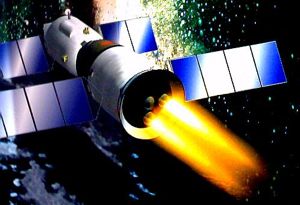
Home - Search - Browse - Alphabetic Index: 0- 1- 2- 3- 4- 5- 6- 7- 8- 9
A- B- C- D- E- F- G- H- I- J- K- L- M- N- O- P- Q- R- S- T- U- V- W- X- Y- Z
Shenzhou Circumlunar

Shenzhou Circumlunar
Shenzhou passing moon in 2003 exhibition.
Credit: © Mark Wade
Status: Design 2003. Thrust: 10.00 kN (2,248 lbf). Gross mass: 10,000 kg (22,000 lb). Height: 9.00 m (29.50 ft). Span: 17.00 m (55.00 ft).
On January 4, Xu Yansong, a senior official of the China National Space Administration, declared that 'China will put men in space in the next six months and send a flyby mission to the moon in four years'. This was followed by a statement in February by Huang Chunping, General Director for Launch Vehicles for China's space program, that 'China has the full capability to send astronauts to the moon'. Then in March 2003, Ouyang Ziyuan announced a three-phase, 15 year plan for unmanned exploration of the moon. He also said a piloted mission to the moon was not a goal for China within the next decade. This authoritatively refuted the earlier reports. Therefore any Shenzhou manned circumlunar mission would probably not occur until 2020 at the earliest.
A circumlunar flight by 2008 was certainly within Chinese capabilities. The decision to postpone a permanent space station until 2010 may have allowed the Chinese to briefly consider alternate missions. A circumlunar mission would be a real prestige item, far more interesting to the world than a small space station.
The technology would all be available for such a mission:
- Rocket stages, either N2O4/UDMH or Lox/LH2, of roughly the right size for a translunar Shenzhou injection already existed and were proven in flight.
- China already had substantial experience in tracking, communications, and control out to geosynchronous orbit (more complex than a simple circumlunar mission)
- Tracking ships were already operational for worldwide coverage of short-term deep-space missions
- The Shenzhou capsule was an aerodynamic copy of the proven Russian Soyuz capsule. Soyuz-shape aerodynamics in returning from the moon were already proven in the 1960's during the abortive Russian L1 manned lunar program. The capsule would be capable of re-entry on a return from the moon simply by applying a thicker layer of ablative material to the capsule than was used for earth orbital missions. Similar modifications were considered for Lunar Gemini missions in the 1960's.
Alternatively, China could echo the Soviet L1 approach and use the announced (but unflown) CZ-2E(A) or CZ-3B(A) launch vehicles for direct boost of a stripped-down Shenzhou to the moon.
By 2010 it was planned that the heavy-lift version of the CZ-5 booster series would be available. This would be capable of direct launch toward the moon of a Shenzhou spacecraft equipped with the additional propellants required to insert itself into lunar orbit, conduct mapping or survey missions, and then boost itself out of lunar orbit for a return to the earth.
In fact, the heavy lift booster was not to be available until after 2012, and the conservative Shenzhou program abandoned any lunar goals and would not attempt any space station launch until the same year.
Mass breakdowns for the various scenarios would be as follows:
- Scenario: 2 Launches: Lox/LH2 Stage (14,300 kg) plus an all-up Shenzhou (7,800 kg) – requiring an upper stage adapted from the CZ-3A Stage 3, boosted by a CZ-2F or CZ-2E(A) launch vehicle
- Scenario: 2 Launches - N2O4/UDMH Stage (14,000 kg) plus a stripped Shenzhou (6,600 kg) – requiring an upper stage adapted from the CZ-4A Stage 3, boosted by a CZ-2F/CZ-2E(A) launch vehicle.
- Scenario: 1 Launch - Stripped Shenzhou (6,000 kg) boosted by a CZ-3B(A) launch vehicle.
- Scenario: 1 Launch - Shenzhou Lunar Orbiter (10,000 kg) boosted by a CZ-5-5.0 launch vehicle.
Family: Chinese Manned Spacecraft, Lunar Flyby, Manned Circumlunar. Country: China. Agency: CASC. Bibliography: 460.
 | Shenzhou Circumlunar Shenzhou in full thrust, heading for deep space, at 2003 exhibition. Credit: © Mark Wade |
Back to top of page
Home - Search - Browse - Alphabetic Index: 0- 1- 2- 3- 4- 5- 6- 7- 8- 9
A- B- C- D- E- F- G- H- I- J- K- L- M- N- O- P- Q- R- S- T- U- V- W- X- Y- Z
© 1997-2019 Mark Wade - Contact
© / Conditions for Use